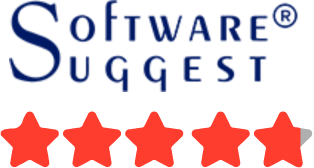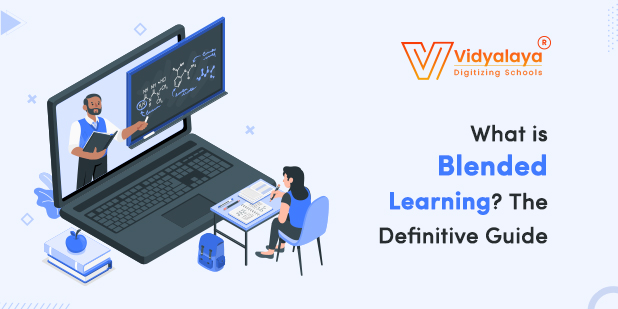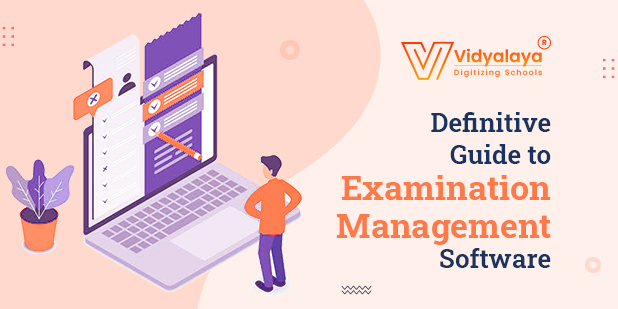Imagine a scenario of learning a complex topic, let’s say the germination process of EVS. In a traditional learning method, the teacher would have explained this topic by explaining the process step-by-step and drawing the phases of the process. Verbal explanations and static drawings are not enough to understand the topic in-depth. Now, switch to another classroom where the teacher is explaining the same topic in innovative ways like slideshows or videos illustrating the phases of the process with proper animation. Which method do you find more interesting? Definitely the second one, right? If yes, then welcome to blended learning! Learn what is this new approach, what do we blend, and why it is becoming the face of the new-age learning process in the past 10 years, right here!
What is blended learning?
Blended learning is an innovative learning approach that integrates the best of both instructor-led brick-and-mortar classroom learning and online learning methodologies and fulfills the evolving needs of modern-age learners. It differs from the full-fledged eLearning approach in that the online portion of learning is not replaced with face-to-face learning with a teacher. Instead, teachers make the elaboration simple and more understandable with the help of technology. Here, online learning strategies mean online quizzes, discussion groups, videos, and other digital resources.
Leveraging technological aid, Vidyalaya is leading in proposing the increased engagement of blended learning so that learning is not restricted to the walls of the classroom. This integrated approach picks up the best of both traditional and online learning to reciprocate optimal learning outcomes. For in-depth understanding, let us explain it with examples:
Let us say there is a group project which needs discussions and collaboration among the group members. In the traditional learning approach, learners meet each other in a classroom and collaborate and discuss the project. On the contrary, when blended learning is adopted, learners will channel with each other using messengers, online communities, and other digital tools to plan and control the flow of the project. It is clearly seen that blended learning brings efficient learning outcomes with technology-aided file-sharing services and other tools.
What are the different types of blended learning?
Now you have understood the concept of blended learning. Allow me to explain the types of blended learning:
1. Flipped Model:
This model offers more focus on online learning where learners use their curriculum on their own time, either before the classroom sessions or at home. In-class time is completely reserved for active learning and learning new skills. Using this model, learners can learn through online coursework or lectures watching at home and can engage in group exercises and discussions under the guidance of a tutor in the classroom.
2. Rotational Model:
Learners follow a defined schedule and keep on rotating both face-to-face and online learning models. To offer flexibility, schedules are fixed but flexible. This model works best in scenarios where learners need to work in small groups or 1:1 tutoring, or pencil-and-paper assignments.
3. Face-to-face driver Model:
As the name suggests, this is closer to the bricks-and-mortar model as maximum learning takes place in the classroom under the guidance of tutors. This method works best for newbies or slow learners or who lag the learning curriculum.
4. Enriched Virtual Model:
This is similar to the flex model but differs from it in learners priorly to undergoing a scheduled instructor-led classroom session. This model enhances the virtual learning experience, as both participating entities can interact using different digital platforms. An enriched virtual model doesn’t need daily school attendance.
5. Flex Model:
This is a highly personalized model which is crafted according to learners’ needs and has more control over their learning. Most of the learning is carried out online but some instances need face-to-face interaction. To address this, the schedule is designed as per the learner’s flexibility.
Why blended learning is becoming so popular?
The blended learning approach is beneficial for both learners and institutes as it meets the requirements of both entities to the maximum. Here are some of the impactful benefits that boost the decision of blended learning decision:
1. Reduced Cost and Optimal ROI:
Blended learning works on financial aspects of the education process and cuts down the cost significantly through various modes. Like, teachers can guide students from their homes and cut down the traveling cost, and effort. This can also improve productivity. Although eLearning is not free and comes with the necessities of skilled manpower and resources, institutes can ask for free tools available. This innovative approach also simplifies the workload and can save time and effort investment.
2. Wider access to Content:
Move to a bigger canvas with a blended learning concept as you will get access to e-content that is easily available on just one click. Rather than relying on textbooks and paper-based resources, switch to digital content that is available in various modes like audio, video, animation, and text. This can improve the engagement of learners and can create a foundation for student-based learning which is one of the objectives of the Learning Outcomes-based Curriculum Framework.
3. Flexibility:
Feeling online sessions are too fast to understand? Just hit pause. Confused over a complex topic? Discuss in face-to-face lectures. Name your need and let blended learning fulfill it. As this approach allows learners to learn at their own pace and in their comfort zone, it offers maximum flexibility. Additionally, it retains the much-needed warmth of human interaction so that learners can discuss with tutors doubts well before they impact their progress.
4. Personalized Communication:
Bring personalization in the learning and let learners enjoy the process. Combining the best of both approaches, the blended learning tool offers a digital platform for the best tutor-learner collaboration. During face-to-face interaction, a gap is eradicated. This is best achieved in online mode with the help of eLearning tools such as video conferencing, calls, and group calls. All this leads to the best achieved Learning Outcomes-based Curriculum Framework that deals with both academic and soft skills.
5. Increased Knowledge Retention:
This innovative approach may help to ensure that all learners are reached, irrespective of their mode of accessibility – online or offline. As a blend of both modes, it can reinforce the learning to extend the span of knowledge retention as compared to the traditional approach.
How Vidyalaya can help in blended learning implementation?
Vidyalaya recognizes the importance of blended learning and its implementation in today’s age. So, with the aim of digitizing education, the leading ed-tech provider creates a better space for learners and tutors. Keeping an eye on the aim, Vidyalaya can help in the implementation of this advanced approach by deriving the following benefits in its products and will optimize the learning outcomes:
- Better evaluation of students’ performance.
- Seamless online classroom teaching
- In-depth learning
- Innovative teaching techniques
- More student engagement
- Conduction of exams in various modes- MCQs, Descriptive, Debates
Vidyalaya, a pioneer name in the Indian and global education sector for more than a decade, has successfully developed a digital ecosystem where new-age learners are meeting their modern requirements and tapping new heights in academics. With the visionary perspective, we have already integrated the latest learning approaches and have made our products future-ready. Contact us to enquire further!





















